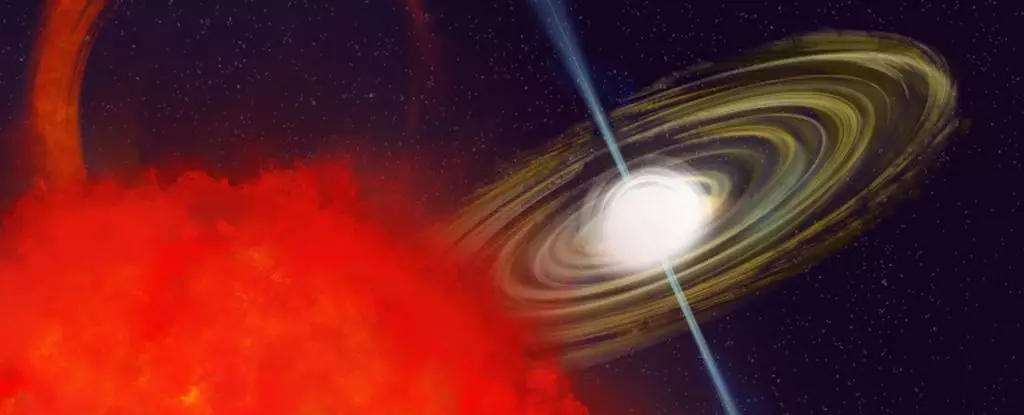In the vast expanse of our galaxy, the Milky Way, astronomers have long been captivated by peculiar flickers of light—transients that challenge our understanding of cosmic behavior. Among these, a newly identified object, CHIME J1634+44, stands out as an unprecedented anomaly. Unlike typical stellar remnants or energetic phenomena, this celestial body exhibits a combination of attributes that make it a genuine cosmic “unicorn.” Its extraordinary long-term pulsations, intense polarization, and unexpected acceleration defy standard classifications, prompting scientists to reevaluate the nature of these cosmic signals. This object’s uniqueness isn’t just about rarity; it’s about fundamentally questioning our current models of stellar remnants and binary interactions.
Deciphering the Nature of Long-Period Transients
Long-period transients (LPTs) are already rare phenomena in our galaxy, characterized by their unpredictable and extended flashing patterns over days or even weeks. CHIME J1634+44, however, takes this rarity to a new level. Its periodic signals, occurring either every 14 minutes or roughly 70 minutes, are complemented by a secondary, long-term cycle of about 70 minutes, exactly five times longer than the shorter period. This two-tiered periodicity suggests a complex system—potentially involving an orbiting companion—challenging the simplicity of typical pulsar models.
The discovery team, led independently by researchers from the Green Bank Observatory and the Netherlands Institute for Radio Astronomy, confirmed the consistency of these signals and their polarization properties. Both teams agree that the object demonstrates a previously unseen pairing of features, including a polarization signal that is entirely circular—an unprecedented trait among LPT sources. These observations suggest that CHIME J1634+44 likely resides within a complex magnetic environment, or perhaps within a system where the emission mechanism operates under extreme physical conditions.
Unprecedented Polarization Points to Exotic Environments
One of the most perplexing aspects of CHIME J1634+44 is its polarization profile. In radio astronomy, polarization provides vital clues about the magnetic field structure and emission mechanisms. Circular polarization, especially at such high levels, indicates highly ordered magnetic fields or unusual plasma conditions. Since this polarization has never been observed in an LPT before, it hints at entirely new physics or previously unconsidered geometries within the source’s immediate environment.
This degree of polarization also raises questions about the emission’s origin: is the signal produced by a rotating magnetic neutron star, a white dwarf with magnetic peculiarities, or an entirely new class of compact object? The extreme polarization underscores the need for more detailed modeling and observation, as it could be key to understanding exotic states of matter or magnetic field configurations that have never been seen before.
Is it a Neutron Star or a White Dwarf? The Ongoing Debate
Perhaps the most contentious aspect of CHIME J1634+44 revolves around its core identity—white dwarf or neutron star? The evidence is conflicted, and each hypothesis raises compelling points. On one side, astronomers led by Dong favor a neutron star, specifically a pulsar. These remnants are renowned for their precise, periodic radio emissions, and some pulsars are known to “spin-up”—accelerate their rotation—when accreting matter from a companion star. The observed increase in the object’s spin rate aligns with this scenario, suggesting active accretion, possibly from a nearby companion caught in a tight orbit.
Conversely, the team led by Bloot points to observational clues from ultraviolet data. They identified a faint UV source indicative of a white dwarf approximately 78% of our Sun’s mass, with temperatures fitting the profile of an accreting white dwarf. This interpretation implies that CHIME J1634+44 could be a rare white dwarf pulsar—an elusive object hypothesized but rarely observed. Such a configuration would combine features of white dwarfs with pulsar-like behavior, a hybrid that challenges classical categorizations.
The debate isn’t just academic; it bears profound implications for astrophysics. Discovering a white dwarf pulsar would expand the taxonomy of stellar remnants, illustrating that extreme conditions and behaviors aren’t exclusive to neutron stars. Confirming a neutron star, meanwhile, would imply an extraordinary case of accretion-driven spin-up, shedding light on binary evolution and magnetic field dynamics.
The Future of Investigating this Stellar Mystery
What remains clear is that CHIME J1634+44 is a puzzle demanding further scrutiny. Its distinctive signatures—including the highest polarization levels recorded for an LPT, its dual periodicities, and its variable spin—indicate an environment teeming with extreme physics. The faint ultraviolet counterpart provides a tantalizing lead, but comprehensive multi-wavelength observations across X-ray, ultraviolet, and radio spectra are needed to unravel its true nature.
If this object proves to be a white dwarf pulsar, it will challenge existing models about the evolution of compact stars and their magnetic fields. If it is a neutron star, then its behavior could redefine our understanding of accretion and spin-up processes in such dense objects. Either outcome promises to deepen our insight into the complex life cycles of stars and the exotic states of matter under astrophysical extremes.
In sum, CHIME J1634+44 exemplifies how the universe continues to surprise us—pushing the boundaries of our knowledge and compelling us to refine the theoretical frameworks that describe the cosmos. This enigmatic beacon, blinked into our view by the relentless curiosity of astronomers, reminds us that the universe still holds countless secrets awaiting revelation.

